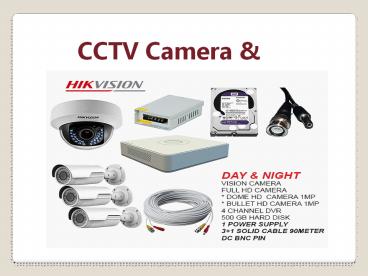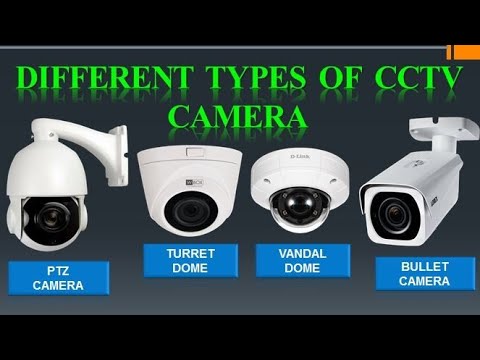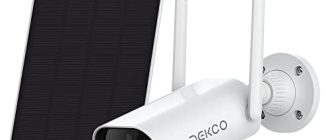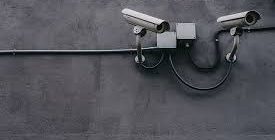
The difference between common CCTV camera types
When it comes to security systems, CCTV cameras are the most common choice. However, not all CCTV cameras are created equal. There are various types of CCTV cameras available on the market, each with its own set of features and benefits. Understanding the difference between these types can help you choose the right CCTV camera for your specific needs.
1. Dome Cameras: These cameras are named for their dome-shaped housing and are commonly used for indoor surveillance. Dome cameras are discreet and can be easily mounted on walls or ceilings. They provide a wide-angle view and are resistant to vandalism.
2. Bullet Cameras: Bullet cameras are the most recognizable type of CCTV cameras. Their long, cylindrical shape makes them easy to spot, which may help deter potential criminals. Bullet cameras are typically used for outdoor surveillance and can be easily installed on walls or poles.
3. PTZ Cameras: PTZ stands for pan-tilt-zoom, which describes the movement capabilities of these cameras. PTZ cameras are remotely controlled and can be panned, tilted, and zoomed in or out to provide a comprehensive view of the area being monitored. They are often used in large surveillance systems.
4. Covert Cameras: Covert cameras, also known as hidden cameras, are designed to be discreet and blend in with the environment. They can be disguised as everyday objects such as clocks, smoke detectors, or even plants. Covert cameras are often used for undercover surveillance.
5. Thermal Cameras: Thermal cameras use infrared technology to detect heat signatures and create images based on the temperature differences in an object or person. They are commonly used for detecting intruders in low-light or completely dark environments.
With so many types of CCTV cameras available, it’s important to consider your specific security needs before making a decision. Whether you need indoor or outdoor surveillance, discreet or visible cameras, the right CCTV camera type is out there for you.
Understanding CCTV Cameras
CCTV (Closed Circuit Television) cameras are a common type of surveillance camera used to monitor and record activities in a specific area. There are various types of CCTV cameras available, each with its own unique features and functionality.
One of the most common types of CCTV cameras is the analog camera. These cameras capture footage as analog signals and require a separate device, such as a DVR (Digital Video Recorder), to convert and store the footage digitally.
On the other hand, IP (Internet Protocol) cameras are becoming more popular. IP cameras capture and transmit footage as digital signals over a network or the internet. They offer higher image quality and flexibility in terms of remote monitoring and access.
In addition to analog and IP cameras, there are also PTZ (Pan-Tilt-Zoom) cameras, which provide a greater degree of control over the camera’s movement. These cameras can be remotely controlled to pan, tilt, and zoom, allowing for flexible surveillance coverage.
Another type of CCTV camera is the dome camera. These cameras are housed in a dome-shaped casing and are often used in indoor settings. Dome cameras are discreet and can be easily mounted on ceilings, making them suitable for monitoring various areas.
Lastly, there are bullet cameras, which are typically used for outdoor surveillance. These cameras are named after their bullet-like shape and are designed to be weatherproof and rugged. They are commonly mounted on walls or poles and offer a fixed focal length for capturing specific areas.
Understanding the different types of CCTV cameras is important in order to choose the most suitable camera for your surveillance needs. Whether you need a basic analog camera or a high-resolution IP camera, each type offers its own set of benefits and considerations.
In conclusion, CCTV cameras are available in various types designed for different applications. By understanding the common types of CCTV cameras, you can make an informed decision when it comes to selecting the right camera for your surveillance requirements.
Factors to Consider
When choosing a CCTV camera, it is important to consider various factors that can affect its performance and suitability for your specific needs. Here are some key factors to consider:
| Difference in Types | There are different types of CCTV cameras available, including dome cameras, bullet cameras, PTZ cameras, and more. Each type has its own advantages and limitations, so understanding the difference between them is crucial in making the right choice for your surveillance needs. |
| Camera Resolution | The resolution of a CCTV camera determines the level of detail it can capture. High-resolution cameras produce sharper and more detailed images, while lower-resolution cameras may not provide the clarity you need. Consider the level of detail required for your surveillance applications to choose the appropriate camera resolution. |
| Camera Sensitivity | The sensitivity of a CCTV camera refers to its ability to capture clear images in low-light conditions. Cameras with higher sensitivity are better suited for low-light environments, such as outdoor areas at night. Consider the lighting conditions in your surveillance area to select a camera with the appropriate sensitivity. |
| Camera Lens | The lens of a CCTV camera determines the field of view and focal length. A wider field of view allows for monitoring larger areas, while a longer focal length provides more zoom capabilities. Consider the specific surveillance requirements of your area to choose the right lens for your CCTV camera. |
| Camera Features | CCTV cameras can come with a variety of features, such as motion detection, audio capabilities, night vision, and remote access. Consider the additional features that may be beneficial for your surveillance needs and choose a camera that offers the desired functionality. |
| Camera Placement | The placement of a CCTV camera plays a crucial role in its effectiveness. Consider the location and surroundings of your surveillance area to determine the most appropriate camera placement. Factors to consider include the height, angle, and coverage area of the camera. |
By considering these factors, you can make an informed decision when selecting a CCTV camera that meets your specific requirements and provides optimal surveillance coverage.
Analog CCTV Cameras
Analog CCTV cameras are one of the common types of CCTV cameras available in the market. The main difference between analog CCTV cameras and other types is the way they transmit video signals.
Analog CCTV cameras use traditional analog transmission methods to send video signals to a recording device, such as a DVR (Digital Video Recorder). The video signals are transmitted through coaxial cables, which then need to be connected to the DVR for recording and monitoring purposes.
One advantage of analog CCTV cameras is their affordability. They are generally more cost-effective compared to other types of CCTV cameras, making them a popular choice for small businesses and residential properties.
However, analog CCTV cameras have limitations in terms of image resolution and quality. They usually offer lower video resolution, typically measured in TVL (Television Lines) or pixels. As a result, the images captured by analog cameras may not be as clear and detailed as those captured by other types, such as IP cameras.
Nevertheless, analog CCTV cameras still serve their purpose in many settings and can provide adequate surveillance coverage for basic security needs. They are relatively easy to install and operate, making them a convenient choice for those who are not particularly tech-savvy.
In summary, analog CCTV cameras:
- Use traditional analog transmission methods
- Transmit video signals through coaxial cables
- Are more affordable compared to other types of CCTV cameras
- Offer lower video resolution and image quality
- Are easy to install and operate
HD-CVI CCTV Cameras
When it comes to types of CCTV cameras, one popular option is the HD-CVI CCTV camera. HD-CVI stands for High Definition Composite Video Interface, and it is a relatively new technology that is gaining popularity.
The main difference between HD-CVI cameras and other types of CCTV cameras is the way they transmit video signals. Unlike traditional analog cameras that use coaxial cables or IP cameras that use network cables, HD-CVI cameras use the same type of coaxial cable used by analog cameras but are capable of transmitting high-definition video.
The advantage of HD-CVI cameras is that they provide high-quality video resolution, typically ranging from 720p to 4K. This makes them ideal for areas where clear and detailed surveillance footage is required, such as retail stores, banks, and other high-security locations.
Another advantage of HD-CVI cameras is that they can transmit video signals over long distances without losing video quality. This is because HD-CVI cameras use digital signals, which are less susceptible to signal degradation over long cable lengths.
HD-CVI cameras also offer other features commonly found in CCTV cameras, such as infrared night vision, motion detection, and remote access. These features make HD-CVI cameras versatile and suitable for various surveillance applications.
In summary, HD-CVI CCTV cameras are a type of high-definition camera that uses coaxial cables to transmit video signals. They provide high-quality video resolution and can transmit signals over long distances without losing quality. With their advanced features, HD-CVI cameras are a popular choice for many surveillance applications.
HD-SDI CCTV Cameras
When it comes to CCTV cameras, there are several different types available on the market. One of the most popular options is the HD-SDI CCTV camera. HD-SDI stands for High Definition Serial Digital Interface, and it offers a significant difference in video quality compared to other common cctv camera types.
HD-SDI cameras are capable of capturing high-resolution video, typically at 1080p or even higher. This means that the footage captured by these cameras is much clearer and more detailed than what you would get with standard definition cameras. If you’re looking for crystal clear images and videos, then HD-SDI cameras are a great choice.
In addition to the excellent video quality, HD-SDI cameras also offer a difference in terms of connectivity. These cameras use a coaxial cable to transmit video signals, just like traditional analog cameras. However, instead of using the older composite video signal, HD-SDI cameras use a digital signal, which allows for the transmission of high-definition video without any loss of quality.
Another difference you’ll find with HD-SDI cameras is the way they handle video recording. These cameras often come with built-in storage options, such as SD or microSD card slots. This means that you can record and store video directly on the camera itself, without the need for an external DVR (Digital Video Recorder). This can be a convenient option if you’re looking for a simple and compact CCTV setup.
Overall, HD-SDI CCTV cameras offer a difference in video quality and connectivity compared to other common cctv camera types. With their high-resolution video and digital signal transmission, these cameras are a great choice for those who want to capture clear and detailed footage. Additionally, the built-in storage options provide added convenience for recording and storing video. Consider investing in an HD-SDI CCTV camera if you want a top-of-the-line surveillance system.
IP CCTV Cameras
IP CCTV cameras, also known as network cameras, are a common type of CCTV camera used in surveillance systems. The main difference between IP CCTV cameras and other types of CCTV cameras is the way they transmit and store video footage.
Unlike traditional analog CCTV cameras that transmit video signals through coaxial cables to a DVR for storage, IP CCTV cameras use an Internet Protocol (IP) network to transmit and store video. This means that IP CCTV cameras can be connected to the internet and accessed remotely, allowing users to view live footage and playback recordings from anywhere with an internet connection.
Another difference between IP CCTV cameras and other types of CCTV cameras is the image quality. IP CCTV cameras typically offer higher resolution and better image clarity compared to analog cameras. This is because IP cameras capture and transmit digital video signals, whereas analog cameras convert the video signal into analog format before transmission.
In addition to higher image quality, IP CCTV cameras also offer more advanced features compared to analog cameras. These features include facial recognition, motion detection, and remote access control. IP cameras can also be integrated with other security systems, such as access control systems and alarm systems, to provide a comprehensive surveillance solution.
Overall, IP CCTV cameras are a popular choice for surveillance systems due to their high image quality, advanced features, and remote accessibility. However, they may require more bandwidth and storage capacity compared to analog cameras due to the larger file sizes of digital video footage.
In summary, the main differences between IP CCTV cameras and other types of CCTV cameras are the way they transmit and store video footage, their image quality, and their advanced features. IP cameras use an IP network for transmission and storage, offer higher resolution and better image clarity, and provide advanced features like facial recognition and remote access control.
Wireless CCTV Cameras
Wireless CCTV cameras are one of the common types of CCTV cameras used for surveillance purposes. As the name suggests, these cameras do not require any wired connections for transmitting video signals. Instead, they use wireless technology to transmit the video feed to a receiver or a recorder.
These cameras are convenient to install as they don’t require complex wiring. They can be easily mounted anywhere within the range of the wireless signal, making them flexible for various surveillance needs. The wireless transmission range can vary depending on the specific camera model and the environment in which it is installed.
One of the advantages of wireless CCTV cameras is their ability to be easily repositioned. They can be moved to different locations without the need to rewire or reconfigure the whole system. This makes them suitable for temporary surveillance needs or for areas where permanent installation is not possible or desired.
However, it’s important to note that wireless CCTV cameras can be susceptible to interference from other wireless devices or physical obstructions such as walls or metal objects. This interference can affect the quality of the video feed or even disrupt the connection entirely. To mitigate this issue, it’s important to choose high-quality wireless CCTV cameras that have strong signal strength and interference-reducing features.
In summary, wireless CCTV cameras are a popular type of camera for surveillance due to their convenience and flexibility. They offer easy installation and repositioning capabilities, making them suitable for various surveillance needs. However, it’s important to consider potential signal interference when choosing and installing wireless CCTV cameras.
Dome CCTV Cameras
Dome CCTV cameras are a common type of CCTV camera that is widely used for surveillance purposes. The main difference between dome CCTV cameras and other types of CCTV cameras is their shape and design. As the name suggests, dome CCTV cameras are shaped like a dome, with a rounded exterior that helps to obscure the camera’s direction and make it less obvious to potential intruders.

One of the key advantages of dome CCTV cameras is their versatility. They can be installed in a variety of locations and are suitable for both indoor and outdoor use. Dome CCTV cameras are often used in places like airports, shopping malls, and parking lots, where their discreet design and wide field of view make them ideal for monitoring large areas.
In addition to their versatility, dome CCTV cameras also offer a number of other features that make them a popular choice for surveillance. Many dome CCTV cameras are equipped with pan-tilt-zoom (PTZ) functionality, which allows the camera to be remotely controlled and adjusted to capture different angles and zoom levels. This makes it easier for operators to monitor and track objects or individuals of interest.
Another advantage of dome CCTV cameras is their vandal-resistant design. The dome-shaped exterior of the camera is typically made of high-quality materials that are resistant to tampering and damage. This makes dome CCTV cameras suitable for use in high-risk areas where there is a risk of vandalism or attempted theft.
In conclusion, dome CCTV cameras are a popular choice for surveillance due to their versatile design, wide field of view, and additional features such as PTZ functionality. Their discreet appearance and vandal-resistant design make them an ideal choice for both indoor and outdoor surveillance applications.
Bullet CCTV Cameras
Bullet CCTV cameras are one of the most common types of cameras used in CCTV systems. They are named after their shape, which resembles a bullet or lipstick tube. These cameras are designed for outdoor use and are often used for surveillance of large areas such as parking lots, streets, and building exteriors.
The main difference between bullet CCTV cameras and other types of CCTV cameras is their design and form factor. Bullet cameras are typically long and cylindrical, with a built-in lens and a protective housing. This design allows for easy installation and adjustment, as well as protection against the elements.
One of the key advantages of bullet CCTV cameras is their long-range capabilities. Many models are equipped with powerful zoom lenses, allowing for detailed monitoring of distant objects. Additionally, bullet cameras often feature infrared (IR) technology, which enables them to capture clear images even in low-light or nighttime conditions.
Another benefit of bullet CCTV cameras is their visible deterrent effect. The presence of these cameras can act as a deterrent to potential criminals, as they are highly visible and indicate that a property is being monitored. This can help to prevent theft, vandalism, and other criminal activities.
In summary, bullet CCTV cameras are a popular choice for outdoor surveillance due to their rugged design, long-range capabilities, and visible deterrent effect. They are ideal for monitoring large areas and can provide clear images even in low-light conditions. If you need a reliable and effective CCTV camera for your outdoor security needs, a bullet camera may be the right choice for you.
PTZ CCTV Cameras
PTZ (pan-tilt-zoom) CCTV cameras are a common type of camera used in surveillance systems. These cameras differ from other types of CCTV cameras in their ability to pan, tilt, and zoom, allowing for greater flexibility and coverage.
One of the key differences between PTZ cameras and other types of CCTV cameras is the ability to remotely control the camera’s movements. With PTZ cameras, users can adjust the camera’s position, pan or tilt the camera to change the viewing angle, and zoom in or out to focus on specific areas of interest.
PTZ cameras are often used in large surveillance systems where a wide coverage area is needed. They are commonly installed in areas such as parking lots, stadiums, and city centers where a single fixed camera may not be sufficient to monitor the entire area.
The pan-tilt-zoom functionality of these cameras allows for real-time monitoring and tracking of suspicious activity. The ability to pan and tilt the camera means that users can follow an object or person as they move across the scene, while the zoom feature allows for detailed observation of an individual or event.
PTZ cameras are typically more expensive than other types of CCTV cameras due to their advanced features. However, the flexibility and versatility of these cameras make them an ideal choice for larger surveillance systems or areas that require a high level of monitoring and control.
| Wide coverage area | Higher cost |
| Remote control capabilities | More complex installation |
| Real-time monitoring and tracking | Require constant manual control |
| Zoom feature for detailed observation |
Day/Night CCTV Cameras
The main difference between day/night CCTV cameras and other types lies in their image sensors. Day/night cameras usually feature a larger image sensor that can capture more light, enabling them to produce clear and detailed footage even in low-light environments. In addition, they are equipped with infrared (IR) cut filters that automatically adjust depending on the lighting conditions.
During the day, the IR cut filter blocks infrared light, allowing the camera to capture colors accurately. As the light diminishes, the filter is removed, allowing the camera to utilize the available infrared light and switch to black and white mode. This enables the camera to capture detailed images even in complete darkness.
Day/night CCTV cameras are commonly used in outdoor surveillance applications where lighting conditions vary throughout the day. They are ideal for monitoring areas such as parking lots, streets, and building exteriors. Additionally, their ability to capture clear footage at night makes them suitable for securing areas that require 24/7 monitoring.
When choosing a day/night CCTV camera, it is important to consider factors such as resolution, lens type, and infrared range. Higher resolution cameras provide more detailed images, while different lens types offer varying field of view options. The infrared range determines how far the camera can effectively capture night-time footage.
|
|
IR CCTV Cameras
IR CCTV cameras, also known as infrared CCTV cameras, are a type of camera that uses infrared technology to capture images in low light or complete darkness. The main difference between IR CCTV cameras and other types of CCTV cameras is their ability to provide clear and visible images even in low light conditions.
IR CCTV cameras are equipped with infrared LEDs (Light Emitting Diodes) that emit infrared light. This infrared light is not visible to the human eye but is detected by the camera’s image sensor. The image sensor then captures the infrared light and converts it into a visible image.
These cameras are ideal for areas that require surveillance during nighttime or in environments with minimal lighting. They can be used both indoors and outdoors and are commonly used in applications such as home security, office monitoring, and perimeter surveillance.
One of the advantages of IR CCTV cameras is their ability to capture images in complete darkness. These cameras can produce high-quality images even when there is no visible light available. This feature makes them a popular choice for areas where security is critical during nighttime.
Another advantage of IR CCTV cameras is their ability to provide clear images in low light conditions. These cameras are designed to enhance the visibility of objects in dimly lit environments, allowing for better surveillance and identification.
It is important to note that while IR CCTV cameras are effective in low light conditions, their range may vary. The effectiveness of the infrared light emitted by the camera depends on factors such as the camera’s specifications and the environment in which it is deployed.
In summary, IR CCTV cameras are a type of camera that uses infrared technology to provide clear and visible images in low light or complete darkness. They are especially useful for surveillance in areas with minimal lighting and offer advantages such as capturing images in complete darkness and enhancing visibility in low light conditions.
Thermal CCTV Cameras
Thermal CCTV cameras are a type of CCTV camera that uses thermal imaging technology to capture and display images. Unlike traditional CCTV cameras, which rely on visible light to capture images, thermal CCTV cameras detect the heat emitted by objects and use this thermal radiation to create an image.
The main difference between thermal CCTV cameras and other types of CCTV cameras is their ability to detect heat. This makes them particularly useful for surveillance in low light or no light situations, as well as in areas with poor visibility or adverse weather conditions.
Thermal CCTV cameras are often used in security applications, such as monitoring perimeter fences, detecting intruders, and identifying objects or people in low light conditions. They can also be used in industrial settings to detect overheating equipment or identify energy leaks.
One advantage of thermal CCTV cameras is their ability to detect heat signatures, which can be useful in situations where traditional CCTV cameras may fail, such as in dense fog or smoke. Thermal CCTV cameras can also be more difficult to tamper with or evade, as they do not rely on visible light to capture images.
However, thermal CCTV cameras do have some limitations. They are typically more expensive than traditional CCTV cameras and require specialized equipment to process and analyze the thermal images. Additionally, thermal CCTV cameras may not provide the same level of detail and clarity as traditional CCTV cameras, as they rely on heat signatures rather than visible light.
In conclusion, thermal CCTV cameras are a specialized type of CCTV camera that uses thermal imaging technology to detect and capture heat signatures. They are especially useful in low light or no light situations, as well as in areas with poor visibility or adverse weather conditions. While they have some limitations, their ability to detect heat makes them a valuable tool in certain security and industrial applications.
Q&A:
What is the difference between analog and IP cameras?
Analog cameras use analog signals to transmit video footage, while IP cameras use digital signals. This means that IP cameras can provide higher quality images and have advanced features such as remote access and video analytics.
What are the different types of IP cameras?
There are several different types of IP cameras, including dome cameras, bullet cameras, PTZ cameras, and thermal cameras. Dome cameras are typically used for indoor surveillance and have a wide viewing angle. Bullet cameras are more suitable for outdoor use and have a longer range. PTZ cameras can pan, tilt, and zoom to provide greater coverage, while thermal cameras are capable of detecting heat signatures.
Can analog cameras be converted to IP cameras?
Yes, it is possible to convert analog cameras to IP cameras using an encoder. The encoder converts the analog signal to a digital format, allowing the camera to be connected to an IP network and accessed remotely.
What is the difference between NVR and DVR?
NVR (Network Video Recorder) and DVR (Digital Video Recorder) are both used to record and store video footage, but they differ in how they process and transmit the data. NVRs are used with IP cameras and process digital signals, while DVRs are used with analog cameras and process analog signals. NVRs have the advantage of providing higher image quality and more advanced features.






